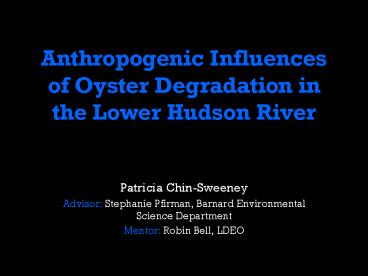Anthropogenic Influences of Oyster Degradation in the Lower Hudson River - PowerPoint PPT Presentation
1 / 10
Title:
Anthropogenic Influences of Oyster Degradation in the Lower Hudson River
Description:
350 sq miles of oyster beds once ran from the Harbor area to Croton Point. ... Top: Leased oyster beds off Prince's Bay and Ward Point, Staten Island (1917) ... – PowerPoint PPT presentation
Number of Views:223
Avg rating:3.0/5.0
Title: Anthropogenic Influences of Oyster Degradation in the Lower Hudson River
1
Anthropogenic Influences of Oyster Degradation in
the Lower Hudson River
- Patricia Chin-Sweeney
- Advisor Stephanie Pfirman, Barnard Environmental
Science Department - Mentor Robin Bell, LDEO
2
History of the New York Oystering Industry
- Oysters in the Hudson date back to
pre-colonialism. - 350 sq miles of oyster beds once ran from the
Harbor area to Croton Point. - NYC was the center of the oystering industry for
the Northeast during the mid- to late-1800s. - Sites of historic oyster beds
- Staten Island, Gowanus Bay, Gravesend Bay,
Jamaica Bay, East River, Kill Van Kull, Arthur
Kill, Newark Bay, Raritan Bay, Shrewsbury River.
3
The Eastern Oyster, Crassostrea viginica
- Habitat Requirements
- Dissolved Oxygen Concentration gt3 ppm required
for survival. - Hard, clean substrate to which spat can attach.
- Salinity 10-30 ppm 15-18 optimal- at which
spawning will occur. - Why Should We Care About These Oysters?
- Filter feeders- remove contaminants/ suspended
matter? cleaner, clearer water. - Indicators of ecosystem health
- Reefs act as shelter to many marine species?
diversity. - Native to NY and the Hudson River.
4
Primary Factors of Influence
- Sedimentation
- Dissolved Oxygen Content
- Overharvesting
- Other Factors
- Salinity changes
- Disease (Dermo, MSX)
- Other Contaminants (PCBs, mercury)
5
The Role of Human Activity
- Increased Siltation/Sedimentation
- Development/Construction
- Anoxia/Hypoxia
- Run-off (agricultural city sewage)
- High coliform levels
- Decreased Salinity
- Excess fresh water inflow
- Overharvesting
- Without returning shells
- ? Severe Habitat Degradation
6
Another Factor to Consider
7
Siltation/Sedimentation
- Causes
- Deforestation
- Development, esp. along the waterfront
- Agricultural practices
- Dredging
- Effects
- Suffocation
- No proper substrate for setting? reduced
recruitment. - Decreased filtering efficiency slower growth
- Reduced sun exposure? less food supply
8
Anoxia/Hypoxia
- Causes
- Untreated sewage garbage dumped directly into
the Hudson. - High Fecal Coliform levels
- Effects
- Suffocation
- Reduced food supply
- Increased intake of pollutants
- By the 1920s, DOC levels in much of the harbor
dropped to critical levels (0-20 Saturation in
summer).
NYCDEP Harbor Survey
9
Overharvesting
- Cause of the more recent almost complete
disappearance - Exploitation
- Poor harvesting practices
- Dredging of oyster beds
- No shells for cultch
Top Leased oyster beds off Princes Bay and Ward
Point, Staten Island (1917). Bottom Same area
in 1937 after industry was shut down.
10
Summary
- Primary factors that caused the present oyster
population conditions - Population Growth
- Development/Agriculture
- Untreated Waste/ Poor Sanitation
- Overharvesting
- Sedimentation/Siltation
- Anoxia?Eutrophication































